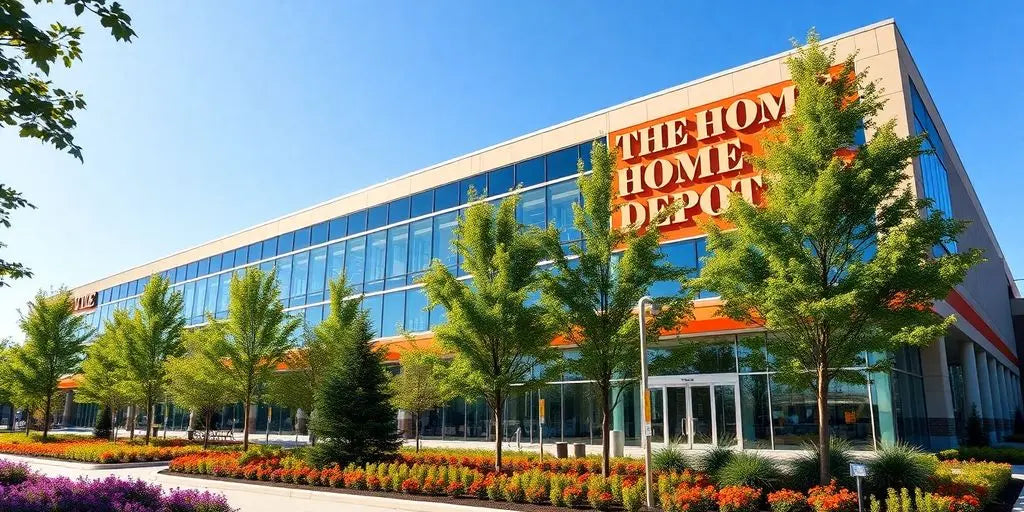The Home Depot is a household name in home improvement, and its headquarters is just as impressive as its reputation. Located in Atlanta, Georgia, the Home Depot HQ is where the magic happens. From innovative ideas to community engagement, this place is at the heart of a company that has transformed how we think about home projects. In this article, we'll explore the significance of the Home Depot HQ address and what it represents for the company and its customers.
Key Takeaways
- The Home Depot HQ is strategically located in Atlanta, Georgia, reflecting its roots and commitment to innovation.
- Over the years, Home Depot has expanded significantly, evolving from a small startup to the largest home improvement retailer in North America.
- Technological advancements at the HQ enhance the shopping experience, including tools like augmented reality and smart home solutions.
- Home Depot is deeply involved in community initiatives, from philanthropy to disaster relief, showcasing its commitment to social responsibility.
- Customer service is a priority at Home Depot, with ongoing training and feedback mechanisms to ensure a positive shopping experience.
Understanding The Home Depot HQ Address
Location Significance
The Home Depot's headquarters being in Atlanta, Georgia, is more than just a pin on a map. It's a strategic choice that reflects the company's roots and its connection to a major metropolitan area. Atlanta provides access to a large talent pool, transportation hubs, and a business-friendly environment. This location has played a role in Home Depot's growth and its ability to serve customers across the United States, Canada, and Mexico. It's also worth noting that the first two Home Depot stores opened in Atlanta, so the location is part of the company's DNA.
Historical Context
To really get why the HQ is where it is, you have to look back at Home Depot's history. Founded in 1978 by Bernie Marcus and Arthur Blank, the company started with a vision of creating a one-stop shop for the do-it-yourselfer. The choice of Atlanta wasn't random; it was about being in a place where they could build something big. The city offered the resources and the market to support their ambitious plans. Over the years, the headquarters has evolved alongside the company, reflecting its growth and its changing priorities. It's a story of how a local business became a global leader, all while staying true to its origins.
Accessibility Features
Accessibility is a big deal for any major corporation, and Home Depot is no exception. The HQ is designed to be accessible to employees, visitors, and partners. This includes things like:
- Easy access to major highways and public transportation.
- On-site parking and shuttle services.
- ADA-compliant facilities throughout the campus.
The company understands that a positive customer experience is crucial in building long-term relationships and generating repeat business. Therefore, the company continuously seeks ways to improve the customer journey, from the moment customers enter the store to the moment they leave with their purchases.
These features aren't just about compliance; they're about creating a welcoming and inclusive environment for everyone who interacts with the company. Plus, with convenient store locations across North America, Home Depot makes it easy for customers to get what they need.
The Evolution Of Home Depot's Headquarters
Founding and Early Years
Home Depot's story began with a vision: a one-stop shop for the do-it-yourselfer. This vision materialized on June 22, 1979, with the opening of the first two Home Depot stores in Atlanta, Georgia. These initial stores were massive, around 60,000 square feet each, dwarfing the competition and stocking about 25,000 products. This was far more than the average hardware store at the time. It's interesting to see how far they've come since then.
Growth and Expansion
From those humble beginnings, Home Depot has grown into the world's largest home improvement retailer. Today, they have approximately 475,000 employees and over 2,300 stores across the U.S., Canada, and Mexico. The typical store now averages 105,000 square feet of indoor retail space. They've also built a strong e-commerce business, offering over one million products. This caters to DIY customers, professional contractors, and those who prefer installation services. The company's commitment to customer experience has been a key factor in its expansion.
Modern Developments
Home Depot continues to evolve, embracing digital marketing and innovative technologies. They've invested heavily in their e-commerce platform, making it easier for customers to shop online. They're also exploring technologies like augmented reality and smart home solutions to stay ahead of the curve. The company faces competition from other retailers, requiring them to continually innovate and differentiate themselves. This includes introducing new product lines, enhancing their online presence, and improving customer service. They also focus on home renovation market by offering comprehensive solutions, specialized services, and expert guidance.
Home Depot's success can be attributed to its strong corporate culture and constant pursuit of better customer service and innovation. They've built a reputation for high-quality products, exceptional customer service, and a vast selection of tools and supplies.
Innovations At Home Depot's Headquarters

Technological Advancements
Home Depot is always trying to find new ways to use tech to make things better for customers. They've put a lot of money into things like augmented reality and smart home stuff. It's all about giving people cool, new options and making things easier. For example, you can use their app to see what furniture looks like in your house before you buy it. They also sell a bunch of smart home devices that can make your life more connected.
Sustainability Initiatives
Home Depot is also working on being more eco-friendly. They're doing things like using more sustainable materials and trying to cut down on waste. They know people care about the environment, and they want to do their part. They're trying to appeal to environmentally-conscious customers and show that they're a responsible company.
Customer Experience Enhancements
Home Depot is focused on making shopping easier and more enjoyable. They're doing things like offering flexible payment options and making sure their stores are easy to get to. They also want to help people with their DIY projects, so they offer workshops and tutorials. They're even thinking about creating a community forum where people can share ideas and get advice. It's all about making Home Depot a place where people can get everything they need for their home improvement projects.
Home Depot is committed to making a positive impact beyond just its business operations. They support local communities and organizations through philanthropic initiatives, such as charitable donations and grants, addressing various social and environmental needs. In times of disaster, its swift response and support through relief efforts highlight its commitment to helping communities in need, further solidifying its brand image as a responsible and caring corporate citizen.
Community Engagement From The Home Depot HQ
Philanthropic Efforts
The Home Depot isn't just about hammers and nails; they put a lot of effort into giving back. Their philanthropic arm supports various causes, often focusing on housing, disaster preparedness, and supporting veterans. They do this through charitable donations and grants to local and national organizations. It's pretty cool to see a big company using its resources to address real-world needs.
- Financial contributions to non-profits
- In-kind donations of materials for community projects
- Employee volunteer programs
Home Depot's commitment to philanthropy extends beyond mere check-writing. They actively seek out partnerships with organizations that align with their values and work to create lasting, positive change in the communities they serve.
Local Partnerships
Home Depot HQ actively engages with the communities surrounding its headquarters. This involves partnering with local businesses, schools, and community organizations. These local partnerships help support community development, create job opportunities, and improve the quality of life for residents. It's a way for the company to be a good neighbor and invest in the areas where its employees live and work.
- Sponsoring local events and initiatives
- Collaborating with schools on educational programs
- Supporting local small businesses
Disaster Relief Initiatives
When disaster strikes, Home Depot often steps up to provide assistance. They offer supplies, resources, and support to communities affected by hurricanes, floods, wildfires, and other disasters. This includes donating building materials, providing volunteer assistance, and partnering with relief organizations to get aid to those who need it most. It's a critical role, showing their commitment to helping people rebuild their lives. They are committed to corporate social responsibility.
| Disaster Type | Relief Efforts |
|---|---|
| Hurricanes | Providing building materials, supplies, volunteers |
| Wildfires | Donating fire-resistant materials, tools |
| Floods | Offering pumps, cleaning supplies, support |
The Role Of Customer Service At Home Depot
Home Depot keeps customer service high on its list. They do a lot of work to make sure that every step of a visit is helpful and friendly. This section breaks down how they do training, how they listen to customer input, and how they are always looking to improve their services.
Training and Development
Staff training is a big deal here. Employees go through a mix of classes, on-the-job learning, and fun hands-on sessions. This helps them work quickly and answer questions the right way. They focus on hands-on training that makes real improvements.
Here are some common training steps:
- In-store workshops to practice skills
- Online sessions for quick refreshers
- Hands-on exercises with real-life scenarios
And check out the table below which shows how often these training programs run:
| Training Type | Frequency | Effectiveness |
|---|---|---|
| In-Store Workshops | 12 times/yr | 88% |
| Online Sessions | 24 times/yr | 92% |
| Hands-on Practice | 6 times/yr | 85% |
Customer Feedback Mechanisms
Feedback is taken seriously at Home Depot. After a shopping trip, customers are encouraged to share their thoughts. Through surveys, suggestion boxes, and digital platforms, the company collects ideas and concerns. Some of the key steps include:
- Collecting reviews at the register and online
- Regular customer interviews
- Ongoing evaluation meetings with the service team
During these sessions, the team checks trends in feedback and sometimes even talks about trending home decor to see how current style needs might affect service choices.
Service Innovations
Service innovations here come from a mix of new technology and practical changes in the way store staff work. The company isn’t afraid to try new ideas—even if some experiments don’t go perfectly. The focus is always on making sure customers feel heard and helped.
Some key innovations are:
- Mobile assistance tools for staff
- Faster service counters at busy times
- Simplified checkout systems which cut down waiting times
It’s clear that Home Depot values clear and genuine interaction. They test ideas on a small scale first, then tweak them until the process feels just right for every customer.
Overall, Home Depot’s commitment sits at the heart of customer satisfaction. Every new training module or service tweak is meant to make daily shopping easier for everyone.
Future Directions For Home Depot's Headquarters

Strategic Goals
Okay, so what's next for Home Depot? It's not like they're going to sit still. One big thing is probably going to be about becoming the place to go for smart home solutions. Think more smart locks, thermostats that learn your schedule, and lighting you can control with your phone. But it's not just about selling the stuff; it's about helping people get it set up too. Offering installation services could be a game-changer.
- Expand into new markets, especially emerging economies.
- Offer complete home renovation solutions.
- Invest in e-commerce and online customer experience.
Home Depot needs to keep an eye on what people want. If everyone starts caring about tiny homes and minimalist living, they need to be ready with products that fit that trend. It's all about staying flexible.
Adapting To Market Changes
The world is always changing, and Home Depot has to keep up. One thing they're watching closely is how people's tastes are changing. More and more folks care about where their stuff comes from and how it's made. So, Home Depot is thinking about offering more eco-friendly options. Also, they're facing some tough competition from online stores. To win, they need to make their website awesome and give people a reason to shop with them, like really good customer service or special products you can't find anywhere else. The home improvement market is competitive.
Sustainability Focus
Sustainability is a big deal, and Home Depot knows it. They're looking at ways to be greener, like selling more energy-efficient appliances and eco-friendly materials. They could also work on reducing waste in their stores and supply chain. It's not just good for the planet; it's good for business too. People want to shop at places that care about the environment.
Here's a quick look at some potential sustainability initiatives:
| Initiative | Description |
|---|---|
| Energy-efficient products | Promoting LED lighting, smart thermostats, and Energy Star appliances. |
| Eco-friendly materials | Offering recycled or sustainably sourced building materials. |
| Waste reduction | Implementing responsible waste management practices in stores and throughout the supply chain. |
Exploring Home Depot's Corporate Culture
Employee Engagement
Home Depot seems to really focus on keeping its employees happy and involved. It's not just about clocking in and out; they want people to feel like they're part of something bigger. I think that's why you often see employees who've been there for years – they feel valued. From what I've seen, they invest in training and development, so employees can grow within the company. This creates a sense of loyalty and encourages people to stick around. It's a smart move, because happy employees usually mean better customer service.
- Regular team-building activities
- Opportunities for advancement
- Employee recognition programs
Diversity and Inclusion
Home Depot seems to be making a real effort to create a workplace where everyone feels welcome. It's not just about ticking boxes; they're trying to build a team that reflects the communities they serve. This means actively recruiting people from different backgrounds, genders, and ethnicities. They also have programs in place to support employees from underrepresented groups. It's good for morale, and it also makes good business sense. A diverse team brings different perspectives and ideas to the table, which can lead to better products and services. They also seem to be aware of sustainable options for their products.
Community Involvement
Home Depot isn't just about selling tools and appliances; they also seem to care about giving back to the community. You often see them involved in local projects, like building homes for veterans or supporting youth sports teams. They also have a strong focus on disaster relief, providing supplies and support to communities affected by hurricanes, floods, and other natural disasters. This kind of philanthropy not only helps people in need but also builds goodwill and strengthens the company's reputation. It shows that they're not just in it for the money; they actually care about making a difference.
It's important for companies to be good corporate citizens. It's not just about making a profit; it's about contributing to the well-being of the communities where they operate.
Wrapping It Up
So, there you have it. Home Depot isn’t just a store; it’s a hub for anyone looking to tackle home projects, big or small. With its headquarters in Atlanta, Georgia, the company has grown from its humble beginnings to become a leader in the home improvement game. They’ve got everything from tools to appliances, and they make it easy to shop, whether you’re in-store or online. Plus, their focus on tech and community support shows they’re not just about selling stuff—they care about making a difference. If you’re ever in the area, checking out the HQ might give you a glimpse into how they keep pushing the envelope in retail. Home Depot is definitely a place where innovation meets everyday needs.
Frequently Asked Questions
What is the address of Home Depot's headquarters?
Home Depot's headquarters is located in Atlanta, Georgia.
When was Home Depot founded?
Home Depot was founded on June 22, 1978.
How many stores does Home Depot have?
Home Depot operates over 2,300 stores across the United States, Canada, and Mexico.
What types of products does Home Depot sell?
Home Depot sells a wide range of products, including tools, building materials, home improvement supplies, and gardening items.
What innovations has Home Depot introduced?
Home Depot has introduced many innovations like online shopping, augmented reality tools, and smart home solutions.
How does Home Depot engage with the community?
Home Depot engages with the community through volunteer work, donations, and disaster relief efforts.









































